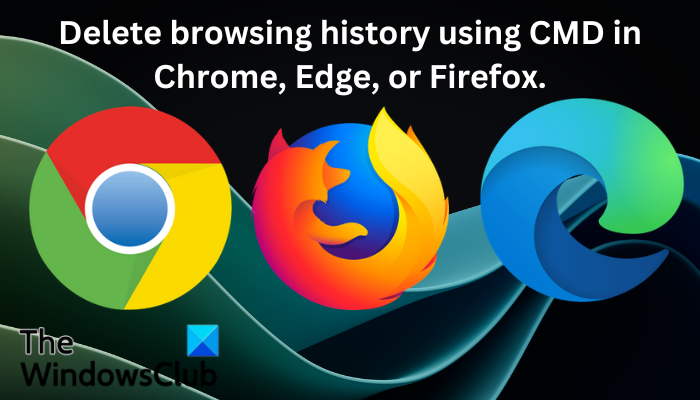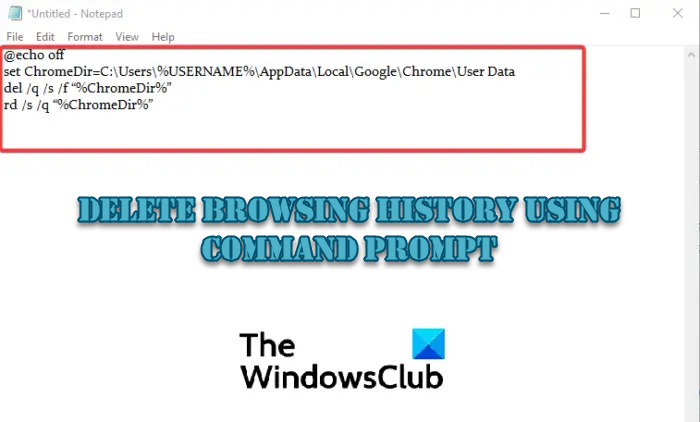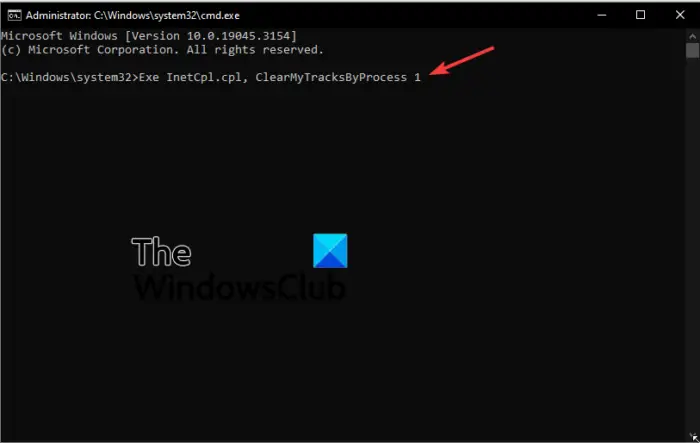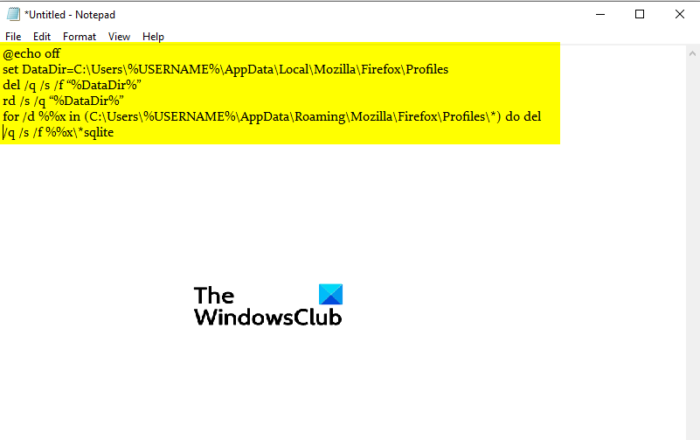In this post, we will discuss how you can delete browsing history using CMD in Chrome, Edge, or Firefox. These browsers store the history of your activities to improve your browsing experience. The history and cache files include scripts, images, and other sections of the sites that help users to load pages faster during their next visit. A user may want to delete browsing history because it has eaten up too much disk space or there are sensitive history files they do not want to land in the wrong hands.

Google Chrome, Mozilla Firefox, Microsoft Edge and all other browsers have internal features that you can use to delete browsing history manually. Using the command line can help you delete browsing history faster and permanently.
Why should I clear browsing history in Chrome, Edge, Firefox
There are several reasons why you should clear your browsing history. The most important is to ensure that your sensitive information is not accessed by people using your computer or other third parties online. Another reason is to create more storage space that historical data occupied. This helps the browser to work smoothly and at optimized speeds. Also, clearing history, cookies, and caches helps you to stop using old forms and auto-fills.
Before clearing the history data, ensure that you have administrative permissions to run CMD, and know the browser path in your Windows files. Also, ensure the browser you intend to delete history data is closed.
Let us now look at how to clear history data in each browser in detail.
Delete Chrome browsing history using CMD

If you would like to delete history data using Command Prompt in Google Chrome, follow the steps below:
- Open your Windows Notepad and type or copy and paste the following command lines:
@echo off
set ChromeDir=C:\Users\%USERNAME%\AppData\Local\Google\Chrome\User Data
del /q /s /f “%ChromeDir%”
rd /s /q “%ChromeDir%” - Go to the File on the top-left of the Notepad window and choose Save As. Click the computer location where you would like to save the document. Under the Save as type option, select the All files option.
- Then, type the name you would wish to name your file but it must end with a .bat extension, and then hit Save. The file extension ensures that the document is saved in the batch script format which we will run later.
- Head over to the Windows search bar and type cmd, select Run as administrator.
- Here, type the batch file path, for example, C:\Location\Path\of\Batch file folder\Batch-name.bat. Replace the names with the exact names in the path.
- Hit Enter on the computer keyboard and let CMD clear Chrome browsing history, then exit the window.
For your information, the commands in the batch file means as follows.
- del erases files located at %ChromeDir%
- echo command hides or shows commands on the screen; it is a batch script command.
- /q commands initiate a quiet mode and there is no confirmation needed from the browser to delete the history data.
- /s is a command that deletes subdirectory data
- /f runs a command to force delete files
- rd command line initiates %ChromeDir% directory deletion
Delete Edge browsing history using CMD

Use the following steps to delete Edge browsing history in Chrome;
- Open Command Prompt as an administrator. When you get the User Account Control message, click Yes to continue.
- To delete internet files, type or copy and paste the following command line and hit Enter on the keyboard:
Rexe InetCpl.cpl,ClearMyTracksByProcess 8
- To delete all Edge browsing history, use the following command line on the Command Prompt:
Exe InetCpl.cpl, ClearMyTracksByProcess 1
TIPS:
Use the command line exe InetCpl.cpl,ClearMyTracksByProcess 2 to clear cookies in your browser.
To clear autofill data from your browser use the command line exe InetCpl.cpl,ClearMyTracksByProcess 16.
The command line exe InetCpl.cpl,ClearMyTracksByProcess 32 is used to clear passwords saved on different sites on your browser.
If you would like to clear everything, from cookies, history data, internet files, and passwords, use the command line exe InetCpl.cpl,ClearMyTracksByProcess 255.
Related: How to Import/Export History in Chrome, Edge, Firefox, Brave
Delete Firefox browsing history using CMD

The process of deleting browsing history data in Firefox is the same as we did with Google Chrome. The only difference is the commands in the Notepad batch file. In this case, type or copy and paste the following commands into the Notepad:
@echo off
set DataDir=C:\Users\%USERNAME%\AppData\Local\Mozilla\Firefox\Profiles
del /q /s /f “%DataDir%”
rd /s /q “%DataDir%”
for /d %%x in (C:\Users\%USERNAME%\AppData\Roaming\Mozilla\Firefox\Profiles\*) do del /q /s /f %%x\*sqlite
Follow every step we performed in Chrome to delete Firefox history data.
We hope you find something helpful here.
Read: How to clear Browser Cache, Cookies, History in Chrome and Firefox
Why is my browsing history not deleting?
If the browser history is not deleting, even when you force it, your browser might be having some issues like bugs, corruption, glitches, etc. These are temporary issues that can be fixed by restarting your browser or your PC. If the issue persists, try to update or reinstall the browser and see if the error is fixed. You may also consider clearing history data using Command Prompt, it rarely fails and requires no permission or confirmation from the browser.
Next tip: Prevent Chrome or Edge from saving Browsing History and Data
Can browser history be traced after being deleted?
Once you delete browsing history in Chrome, Firefox, Edge, etc, you only clear data in your local directories. However, the browsing history is still on the servers and can be traced by the browsers. Your online activities are tracked with your permission to enhance good browsing and personalized content online.

